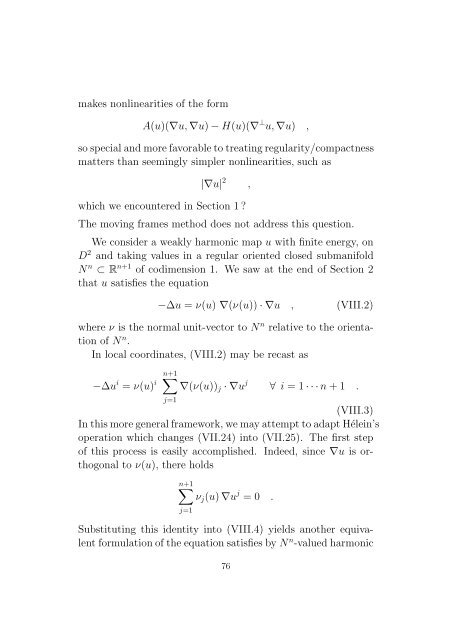Conformally Invariant Variational Problems. - SAM
Conformally Invariant Variational Problems. - SAM
Conformally Invariant Variational Problems. - SAM
Create successful ePaper yourself
Turn your PDF publications into a flip-book with our unique Google optimized e-Paper software.
makes nonlinearities of the form<br />
A(u)(∇u,∇u)−H(u)(∇ ⊥ u,∇u) ,<br />
sospecialandmorefavorabletotreatingregularity/compactness<br />
matters than seemingly simpler nonlinearities, such as<br />
|∇u| 2 ,<br />
which we encountered in Section 1?<br />
The moving frames method does not address this question.<br />
We consider a weakly harmonic map u with finite energy, on<br />
D 2 and taking values in a regular oriented closed submanifold<br />
N n ⊂ R n+1 of codimension 1. We saw at the end of Section 2<br />
that u satisfies the equation<br />
−∆u = ν(u) ∇(ν(u))·∇u ,<br />
(VIII.2)<br />
where ν is the normal unit-vector to N n relative to the orientation<br />
of N n .<br />
In local coordinates, (VIII.2) may be recast as<br />
∑n+1<br />
−∆u i = ν(u) i ∇(ν(u)) j ·∇u j ∀ i = 1···n+1 .<br />
j=1<br />
(VIII.3)<br />
Inthismoregeneralframework,wemayattempttoadaptHélein’s<br />
operation which changes (VII.24) into (VII.25). The first step<br />
of this process is easily accomplished. Indeed, since ∇u is orthogonal<br />
to ν(u), there holds<br />
∑n+1<br />
ν j (u)∇u j = 0 .<br />
j=1<br />
Substituting this identity into (VIII.4) yields another equivalentformulationofthe<br />
equationsatisfiesby N n -valuedharmonic<br />
76
















